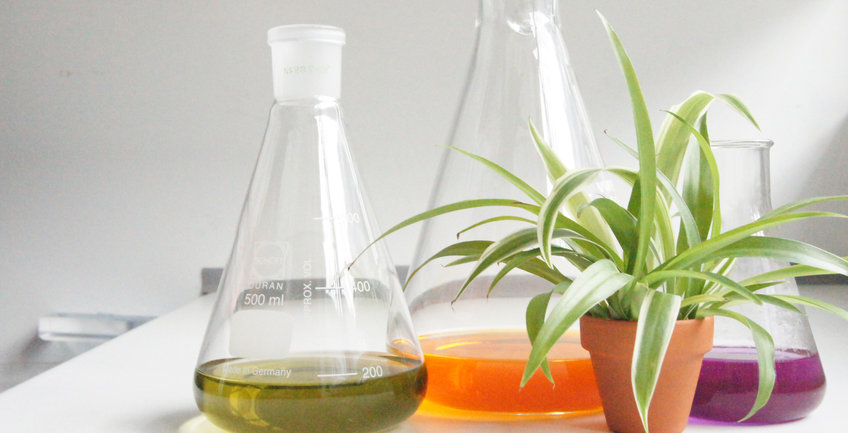
Sustainable Solvents for Green Processes
Nature inspired approach in biomass processing
Development of sustainable technologies that will have a low carbon footprint and provide minimal influence on ecosystem is among the important modern concerns. Biomass as sustainable source of fuels, chemicals and materials is already in the middle of attention as an alternative to conventional fossil-based resources. The vast diversity of biomass opens myriads of opportunities to replace fossil-based products, but also tied to challenges of processing biomass while gaining maximal advantages accounting peculiarities of each type of biomass. This approach is not only maximizes the profits on demand of the market, but also within the Green Chemistry principles of recourses and energy economy and minimal harm.
In the heart of the biomass processing, same as most of the chemical processes, are solvents as the media for the reaction and purification processes. Development of the alternative solvents to conduct reactions, extractions or purifications takes distinguished paths, like ionic liquids, supercritical carbon dioxide or even solvent-free reactions. In our research, we extended the concept of Natural Eutectic Solvents from hosting the reaction to contributing as a reagent, and used this Reactive Eutectic Mixture to optimize the biomass processing.

In the last several decades eutectic mixtures of different compositions were successfully used as solvents for vast amount of chemical processes, and only relatively recently they were discovered to be widely spread in nature. Composed of bioorganic molecules and metabolites, natural eutectic media in cells are responsible for preserving living organisms in the harsh cold or dry conditions. Furthermore, they are regarded as a third liquid media of the living cells, that explains high contents of poorly water soluble compounds in cells, and can be a missing link to disclose the mechanism of cellulose and lignin synthesis.
Reactive eutectic media (REM) for solvent-free synthesis
We investigate the potential of REM’s, taking the principles of green chemistry to heart. This allows certain reactions to be performed under solvent- and catalyst-free conditions, while giving superior atom and energy economy and high yields. Due to its economic advantages, the approach of the reactive eutectic mixtures can pave the way for green technologies to the large scale industrial applications in organic synthesis. Particularly advantages are the liquid state of those mixtures at the reaction temperatures and their ability to effectively absorb microwave energy that allows to use those systems for the microwave synthesis, and particularly for the flow reactors.

In our group, this approach was successfully used to synthesize different fluorophores of blue or red color from bio-based starting materials, flavoring agents with antimicrobial properties from saccharides.
Nanocellulose isolation in REM
Eutectic mixtures based on ammonium formate have a low viscosity, so that they can be used as harmless and sustainable reaction media, for instance for the treatment of lignocellulosic biomass. At elevated temperatures, they also provide reactivity towards aminolysis and reductive amination, allowing the isolation of cationic, amino-functionalized colloidal cellulose nanocrystals (CNCs) from cellulose sources. Their low degree of substitution with amino groups, which are found in pristine natural biopolymers as well, ensures biocompatibility and biodegradability. Our novel CNC presents a sustainable bio-based nanoparticle that can be used for thin films, gas-tight coatings, as mechanical reinforcing agent, and Pickering stabilizer, enabled by its distinguishing features.

Additive manufacturing with inks based on Pickering emulsions
Additive manufacturing is a constantly and rapidly growing field both in science and industry due to the flexibility of the approach and use of different methods to print the objects, minimal wastes in production and versatility of the used materials. 3D printing also rapidly enters the field of biomedicine. The inks for the bioprinting has specific requirements regarding their safety, biocompatibility and biodegradability. We developed inks based on CNC-stabilized Pickering emulsion for 3D printing that combines safety features due to the use of all-natural components with the excellent printability and shape fidelity of the printed objects.

Hemicellulose
Hemicellulose has become a very promising material, for its excellent biodegradability, bioactivity and biocompatibility, which is valuable for applications in the fuel, adhesives, pharmaceutical, food safety and wastewater treatment. As an abundant renewable natural polysaccharides, hemicellulose exists widely in plants. Its chemical structure consisted of the main chain linked by β(1–4) glycosidic bonds and short lateral different monosaccharides chain branches without fixed chemical formula. The structure of hemicelluloses vary considerably depending on the source and extraction method, and these differences enabled wealth of properties in the development of bio-based materials. Our research is focus on the application of hemicellulose in different fields by exploring the relationship between its structure and properties through green and sustainable method.

Wood-based construction materials
Wood is the most sustainable solution for otherwise CO2 abuse construction industry. While historically wood is among the first materials used to build houses, it has been abounded in the industrial era, but recently experiences its Renaissance as more sustainable materials are required to sustain the carbon balance. Wood as all lignocellulosic biomass is composed of three main components: cellulose, hemicellulose and lignin. Reconstructing wood-like materials includes isolating those components in their nanoform and subsiquint combination into a clay-like consistency mixture for further processing by hot-pressing, extrusion or 3D printing.

Artificial humic substances for soil improvement
Chemistry provision by fossil carbon sources is trending towards decrease. In this regard, plant biomass is becoming an alternative carbon fragments source, being based, on light and CO2. Hydrothermal treatment of biomass proved itself as an energy effective technology without necessity for pre-drying. Shifting the initial pH of the reaction mixture to basic conditions triggers transformation of biomass into polycondenced structures similar to natural humic substances. Humic substances are the prerequisite for the fertility and improved physical characteristics of soil. Chemistry of those analogs of natural humic substances and its influence on the interaction with soil components, plants and most importantly soil bacteria is the main topic of our research.






